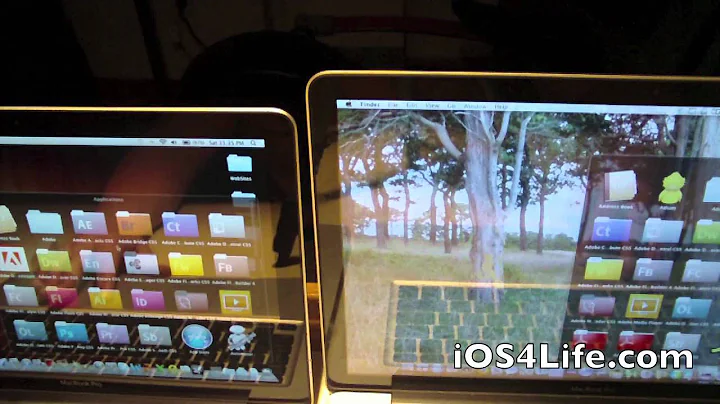Apple's Revolutionary Mac Lineup: Unveiling the Power of the M1 Chip
Table of Contents
- Introduction
- Apple's New Lineup of Macs
- The M1 Chip: A Game-Changing Powerhouse
- Impacts on Pricing and Customer Expectations
- The Message to Chip Makers like Intel
- Changing the Relationship with Software Companies and App Providers
- The Cross Pollination of Software and Hardware
- The Holiday Season Outlook for Apple
- The Importance of the iPhone in Apple's Product Lineup
- Conclusion
💻 Apple's New Lineup of Macs
In a recent virtual event, Apple CEO Tim Cook announced a monumental shift for their signature computers. The tech giant is debuting a new lineup of Macs, marking a significant departure from its reliance on Intel chips. Instead, Apple will be utilizing its own processors. This move comes five months after Apple announced its phased-out reliance on Intel chips, a strategy that many anticipated. With the introduction of the M1 chip, Apple's new Macs are poised to offer unparalleled power, capabilities, battery life, and software compatibility. Let's dive deeper into the implications of this transformative change.
Apple's decision to develop its own processors has far-reaching consequences for the future of their Mac lineup. The M1 chip represents a quantum leap in performance, surpassing any other chip Apple has ever created. With an eight-core GPU, an eight-core CPU, and a 16-core processor for machine learning tasks, the M1 chip is fully equipped to replace lower-end Intel machines. However, Apple's cautious approach is evident, as they continue to sell Intel-based Macs at the high-end of their spectrum, signaling that they are not yet ready to fully commit to their own chips across the board.
💡 Highlights:
- Apple unveils a new lineup of Macs powered by its own M1 chip.
- The M1 chip is the most powerful chip Apple has ever created.
- The new Macs offer exceptional performance, extended battery life, and broader software compatibility.
- Apple continues to sell Intel-based Macs at the high-end.
🏷️ Impacts on Pricing and Customer Expectations
One question that arises from the introduction of Apple's own chips is the potential impact on pricing. Will customers see a decrease or increase in prices? Thus far, Apple has released three Macs equipped with the new M1 chip: the MacBook Air 13-inch, MacBook Pro 13-inch, and Mac mini. Surprisingly, the laptops have maintained their respective price points of $999 and $1300. However, the Mac mini desktop saw a $100 price drop. This suggests that Apple has been able to optimize performance and price for the desktop market. As for the future, it is unlikely that Apple will deviate significantly from its current price ranges for higher-end computers.
Pros:
- Potential for optimized power and affordability in Mac desktops.
- Customers may continue to enjoy Apple's current price ranges for higher-end computers.
Cons:
- Limited price reductions for Mac laptops.
💡 Highlights:
- The MacBook Air 13-inch and MacBook Pro 13-inch retain their price points.
- The Mac mini desktop sees a $100 price drop.
- Apple is unlikely to increase or decrease prices substantially for higher-end computers.
🧩 The Message to Chip Makers like Intel
Apple's decision to transition to its own chips represents a significant blow to long-time partner Intel. While the financial impact on Intel is estimated to be between $3 to $4 billion in the short term, it is crucial to note that Apple accounts for only 7-10% of Intel's annual sales. Nonetheless, losing a name brand like Apple has far-reaching implications for Intel's reputation and may inspire other computer manufacturers to explore alternative chip providers. This shift in the tech landscape could potentially open new opportunities for chip giant Qualcomm, which leads in ARM chip production that Apple is leveraging to create its own designs.
Pros:
- Encourages diversification and competition in the chip market.
- Opens doors for alternative chip providers like Qualcomm.
Cons:
- Intel faces a significant blow in terms of reputation and the loss of a high-profile customer.
💡 Highlights:
- Apple's move deals a blow to Intel's reputation and sales.
- Intel's loss may inspire computer manufacturers to Seek alternatives.
- Qualcomm could potentially benefit from the market shift.
🔄 Changing the Relationship with Software Companies and App Providers
One of the significant advantages of Apple's transition to its own chips is the compatibility it offers with iPhone apps. For the first time, users will be able to run iPhone apps natively on their Macs. While certain iPad apps required adjustments from developers to be Mac-compatible, this transition will enable a seamless experience. Developers can now reach a broader user base with their apps, potentially leading to increased revenues for both developers and Apple's services sector. However, the initial user experience may not be perfect, given that many iPhone apps are optimized for touchscreens. While this may be a minor inconvenience initially, it paves the way for further product improvements.
Pros:
- Expanded app availability and increased revenue for developers.
- Improved relationship between developers, Apple, and users.
Cons:
- Initial user experience may be suboptimal due to touchscreen-optimized apps not designed for Mac's interface.
💡 Highlights:
- Macs can now run iPhone apps natively.
- Increased revenue potential for developers and Apple's services sector.
- Initial user experience may be compromised by touchscreen-optimized apps.
🌐 The Cross Pollination of Software and Hardware
Apple's latest venture into designing both hardware and software for its Mac lineup marks an unprecedented level of integration. This move signifies a deeper cohesion between software and hardware, resulting in a more unified user experience. By controlling both the underlying chips and the software running on them, Apple can optimize their products to deliver superior performance. This level of hardware and software integration further solidifies Apple's competitive edge and sets a precedent for other companies seeking a seamless user experience through closer collaboration between software and hardware development.
Pros:
- Deeper integration between hardware and software leads to improved overall product performance.
- Sets a benchmark for superior user experience through Cohesive development.
Cons:
- Other companies may face the challenge of replicating Apple's software and hardware integration.
💡 Highlights:
- Apple's control over both hardware and software drives a more integrated user experience.
- Sets a standard for superior product performance through holistic development.
🎁 The Holiday Season Outlook for Apple
With the ongoing pandemic, it comes as no surprise that Apple is experiencing a surge in Mac sales. As more people work and educate from home, demand for computers has skyrocketed. While Apple has refrained from providing specific guidance or revenue forecasts due to the circumstances, estimates suggest that Apple may reach its first $100 billion quarter. However, the success of the iPhone will play a vital role in achieving this milestone. Although the recent release of the new Macs has generated significant revenue, the iPhone remains Apple's most crucial product, driving sales across its ecosystem.
Pros:
- Anticipation of Apple reaching a milestone $100 billion quarter.
- Compelling sales of Macs contribute to Apple's revenue.
Cons:
- Mac sales may not have a substantial impact on overall revenue compared to the iPhone.
💡 Highlights:
- Apple may achieve its first $100 billion quarter.
- The success of the iPhone is essential for reaching this milestone.
- Mac sales contribute to Apple's revenue but may not significantly outweigh iPhone sales.
📱 The Importance of the iPhone in Apple's Product Lineup
Considering the significance of the iPhone, it remains the cornerstone of Apple's product lineup. While services hold the Second position in terms of revenue, the iPad, Mac, and Apple Watch are all in contention for the third spot. However, it is essential to acknowledge that customers invest in these secondary devices primarily due to their iPhone usage. The iPhone acts as the catalyst for a broader ecosystem, driving accessory purchases and services subscriptions. Therefore, even as Apple expands its product range, the iPhone's enduring importance remains unwavering.
Pros:
- The iPhone is the key driver of Apple's ecosystem.
- Accessory and services sales are directly linked to iPhone usage.
Cons:
- Overreliance on the iPhone may pose a risk to diversification.
💡 Highlights:
- The iPhone remains the primary revenue generator for Apple.
- Apple Watch, iPad, and Mac compete for the third position in terms of revenue.
- iPhone usage directly impacts accessory and services sales.
Conclusion
Apple's introduction of its own chips in the new lineup of Macs signals a groundbreaking shift in the technology landscape. The M1 chip showcases Apple's commitment to pushing boundaries and developing best-in-class hardware. While the transition may bring minor inconveniences and challenges, the overall benefits for consumers, developers, and Apple's bottom line are substantial. As Apple solidifies its position as a holistic technology provider, the industry watches eagerly to see how these changes will Shape the future of computing. The transition to Apple Silicon represents a bold leap toward an integrated, powerful, and seamless user experience.
FAQ
Q: How will the transition to Apple's own chips affect the performance of Macs?
A: The transition to Apple's own chips, particularly the M1 chip, will significantly enhance the performance of Macs. The M1 chip boasts impressive specifications, such as an eight-core GPU, an eight-core CPU, and a 16-core processor for machine learning tasks. These improvements translate to faster speeds, improved capabilities, and better software compatibility for Mac users.
Q: Will iPhone apps run smoothly on Macs with Apple Silicon?
A: With the transition to Apple Silicon, iPhone apps will be able to run natively on Macs. This means that users can enjoy a seamless experience without the need for additional adjustments or workarounds. However, it's important to note that some iPhone apps may not be fully optimized for Mac's interface, which could impact the user experience initially.
Q: How will the transition to Apple's own chips impact software companies and app providers?
A: The transition to Apple's own chips opens up new opportunities for software companies and app providers. With the ability to run iPhone apps natively on Macs, developers have a wider user base to target and the potential for increased revenue. This shift also strengthens the relationship between developers, Apple, and users, fostering a more interconnected ecosystem.
Q: What can customers expect in terms of pricing for the new lineup of Macs with Apple Silicon?
A: Apple has maintained the price points for the MacBook Air 13-inch and MacBook Pro 13-inch, offering continuity for customers. However, the Mac mini desktop saw a price drop, suggesting that Apple aims to provide a better balance of power and affordability in the desktop market. Going forward, it is unlikely that customers will see significant price changes for higher-end Macs.
Q: Will Apple's switch to its own chips have a long-term impact on chip makers like Intel?
A: Apple's decision to develop its own chips deals a blow to Intel, although the immediate financial impact is relatively small in proportion to Intel's overall sales. However, losing a high-profile customer like Apple can have implications for Intel's reputation and influence other computer manufacturers to explore alternative chip providers. The market shift may inspire diversification and competition, potentially benefitting companies like Qualcomm, which leads in ARM chip production.
Q: How has the COVID-19 pandemic affected Apple's sales and revenue forecasts for the holiday season?
A: Due to the ongoing pandemic and other business reasons, Apple has refrained from providing specific guidance or revenue forecasts for the holiday season. Nonetheless, estimates suggest that Apple may achieve its first $100 billion quarter. The success of iPhone sales will be a crucial factor in reaching this milestone, as the iPhone remains the cornerstone of Apple's product lineup and the driving force behind its ecosystem.
Resources:
 WHY YOU SHOULD CHOOSE TOOLIFY
WHY YOU SHOULD CHOOSE TOOLIFY
































